SIF1 v.1.20 demonstration video fragments
These video files are uploaded to demonstrate abilities of the new codec.
To view the uploaded video fragments, download and install the latest version of the new codec.
To read more detailed information about used compression technique click here.
The main purpose of this survey is to demonstrate that the new codec can be applied to solve the variety of tasks related to video encoding. Therefore, this survey contains all the range of video fragments from high resolution video to video with very low bitrates encoded to be transmitted via the network. All video fragments in the article are sorted according to their quality level starting from FullHD video and ending with video files encoded with extra low bitrate. The majority of video fragments presented in the article are saved without sound not to violate copyrights.
Now we are passing to the demonstration files.
Special comparison. Standard Test fragment Park Joy.
This test fragment has a FullHD resolution and 50 fps frame rate, so for realtime decoding quadcore processor with a frequency of at least 2 GHz is needed.
This is one of the most difficult, if not the most difficult testing sample of standard test samples for codecs. It is the hallmark of the popular x264 encoder, since on this sample x264 surpasses by a large margin all other H.264 codecs. The complexity of this fragment is determined by its extremely high detail and complex multifaceted movement throughout the video. In this case, the most important part of the image have a lower brightness. This leads to the fact that codecs that don't have effective psy model “kill” the result by contrast but not essential parts of the image, and only high-quality codecs with psy optimization are able to show good results.
This test piece was intended for visual comparison of different codecs. This fragments were encoded by the authors of x264. Although this test didn't took place, we will use this fragments. Resoultion is 1920x1080 pixels. Framerate is 50 fps. I-frame interval is 250 frames. Video length is 10 seconds. Bitrate is 14 mbps. This fully complies to the conditions of the test that didn't took place. For comparison you can download this fragment encoded with highest quality x264 preset Placebo and simplified Baseline profile. I want to note that even in Baseline profile H.264 uses Qpel motion compensation and multiple reference frames, that are not yet implemented in the current SIF1 version. Also, you can download the same fragment encoded with highest x264 settings and Placebo preset. It is not difficult to see that the current quality of SIF1 is between x264 Baseline&Placebo and just x264 Placebo presets. And this is despite the fact that development of SIF1 is far from complete and in the future quality will increase significantly.

This frame was diminished for convenient viewing. To see the full image in PNG format, click on the picture (the size of the picture is 3.3 megabytes).
Download. File size: 16.6 megabytes.
The first group of examples. Video encoded with FullHD quality.
After the first stage of decoder optimization, for viewing FullHD video listed below any modern dual-core processor with a clock speed of at least 2 GHz is enough. However, I recommend using Haali Renderer, as usual EVR in Media Player Classic gives too big loss in the speed of decoding. In the future system requirements for decoding FullHD video will be reduced even more.
On this occasion, I want to clarify the situation with such high requirements of the current decoder.
Actual computational complexity of SIF is in line with that of H.264 or somewhat lower. Current code of the decoder doesn't use modern simd processor extensions being restricted for the usage of the old MMX set of instructions. With the appropriate level of code optimization, FullHD decoding with the bitrate of 30 to 40 megabits per second is quite possible on 2 GHz processor. The matter depends on the optimization only, which needs time and effort. Anyone can help with it, as I open the decompressor's source code.
There shouldn't be any problems with hardware video decoding, as the basic part of SIF algorithm is perfectly multithreaded and can be implemented in GPU with DirectX 9 support, needless to mention more up-to-date models.
To show all the possible range of the codec usage, I took two video fragments totally different by their content.
The first fragment: animation
The source is original Blu-ray with 1st episode of “Code Geass R2” (second season of “Code Geass”) anime. Bitrate of the source is more than 25 mbps. This encode is opening from this first episode. It should be noted that this is opening. It's the most hardest part for compression of the entire episode, as so often for anime. If you compress the whole episode the overall bitrate will be approximately two times lower than separately in the opening. It must be borne in mind. So if the bitrate of the opening is about 3.5 mbps, the bitrate of the entire episode with FullHD resolution will be less than miserable 2 mbps. Resolution of comressed file is 1920x1080 pixels. First example is encoded in Quality based mode with V.D. level of 23, second with the V.D.level of 40. Length is 1 minute 30 seconds. Bitrates are 6 and 3,5 mbps. This example demonstrates the adaptive capacity of SIF-transformation. There is practically no ringing at the boundaries of sharp lines in the encoded video. And this despite the fact that the codec doesn't use post filtering and video compression is very strong.
First example. 6 mbps encode.

This frame was diminished for convenient viewing. To see the full image in PNG format, click on the picture (the size of the picture is 2.22 megabytes).
Download. File size: 64.5 megabytes.
Second example. 3.5 mbps encode.

This frame was diminished for convenient viewing. To see the full image in PNG format, click on the picture (the size of the picture is 2.28 megabytes).
Download. File size: 37.9 megabytes.
The second fragment: very noisy video.
The source file is a fragment of The Wrestler movie in BD-rip format. The source bitrate is about 16 megabits per second. This movie was shot in a “pseudoamateur” manner on an extremely noisy film. Therefore, when the source is strongly compressed by a codec that uses postfiltering (for example, h264), the nosies will inevitably get filtered and the picture will become “digital”. This will remove artistic effect related to “pseudoamateur” shooting manner. The way SIF1 compresses noisy sources is different. When compression is strong, noise dynamics is chiefly cut. In this case, original textures on the image are saved and the picture doesn't look like “digital” one. Any other codec that uses postfiltering is unable to do this, unless it adds noises later into unpacked video. I remind that our codec doesn't have any postprocessing. The resolution of the compressed file is 1920x800 pixels. The file was compressed in Quality Based Mode with different V.D. levels: first one is 57, second one is 90. When an ordinary video is compressed, V.D. level of 90 means unsatisfactory video quality, but in this case, only noise dynamics was filtered. The length of the compressed video is 6 minutes 33 seconds. The source file didn't undergo any additional processing. The given example is a good demonstration of the unique feature of the provided codec - better preservation of textures on strongly compressed video files than that made by codecs with postfiltering. In addition, distortion made by SIF are much more pleasant for the eye as they make “analog” picture but not “digital” picture.
First example. 4 mbps encode.
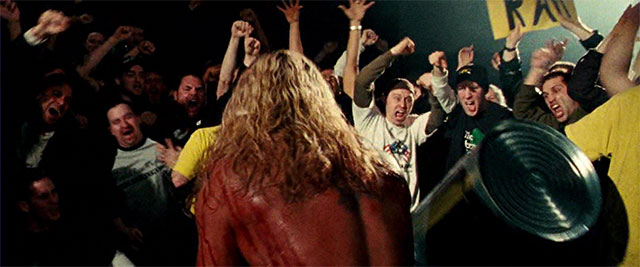
This frame was diminished for convenient viewing. To see the full image, click on the picture.
Download. File size: 190 megabytes.
Second example. 2 mbps encode.
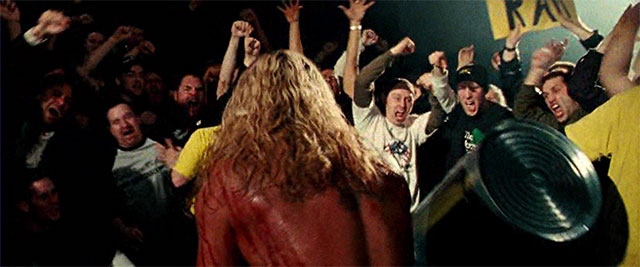
This frame was diminished for convenient viewing. To see the full image, click on the picture.
Download. File size: 91.3 megabytes.
I want to pay your attention that SIF1 operation algorithm was originally developed and optimized for HD video compression and the codec reveals all its potential on such sources.
By the way, the bitrate of about 2 mbps means that you can fit about 4 hours of FullHD video into a single-layer DVD. If we abstract from compression records, the above means that with the provided codec virtually any film can be compressed in FullHD resolution to fit into a single-layer DVD. It will be recorded in high quality with several five-channel audio streams.
The second group of examples: video encoded with 720p resolution.
We used FullHD teaser of The Fountain movie as the source file.
-
This source contains many heterogeneous scenes: with quick and slow movement, bright, dark, etc. Therefore, it suits well for the codec testing. In addition, it is hardly compressible, which is good from the point of view of testing the codec in hard modes.
The resolution of the compressed video is 1280x720. To resize the original video, we used Spline64Resize filter from AviSynth video processing package. There wasn't any other processing of the original video. The teaser length is 2 minutes and 27 seconds. Sound track was compressed into MP3 format with the 128 kbps bitrate. -
The bitrate of the compressed examples is specified for video only without taking into account the bitrates of sound and avi container overhead.
First example: compression with 2 mbps birate.
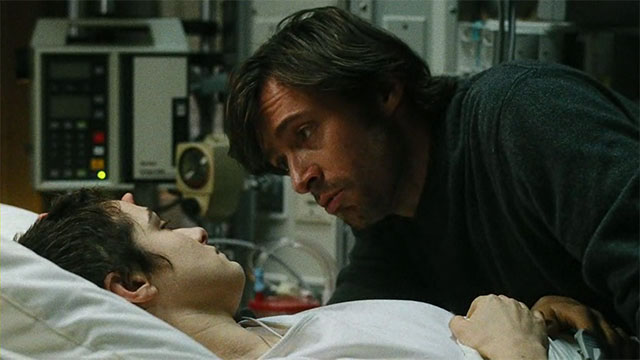
This frame was diminished for convenient viewing. To see the full image, click on the picture.
Download. File size: 37.4 megabytes.
Second example: compression with 1 mbps birate.

This frame was diminished for convenient viewing. To see the full image, click on the picture.
Download. File size: 19.9 megabytes.
You can see from the above examples that even when hardly compressible source file is compressed with ultralow (for 720p) bitrate of 1 megabit, we obtain quite suitable quality. This means that we can compress an average film into 720p resolution with the bitrate of 1.4 - 1.8 megabits using SIF1 and obtain high quality image.
The third group of examples: movie compressed for one CD.
This was very popular video compression direction earlier, but it has lost its applicability now.
We took The Matrix Revolutions movie in HD-DVDrip as the source file. Rip resolution is 1280x528, the bitrate is about 4 megabits per second.
-
This movie can be reasonably considered the standard sample of hardly compressible video. Approximately half of the movie is made of hardly and extremely hardly compressible scenes. The movie also has very dark fragments, which allows testing the quality of bitrate control algorithms in codecs.
-
The resolution of the compressed video is 736x304 (approximately DVD resolution). To resize the source file, we used Spline64Resize filter from AviSynth video processing package. There wasn't any other processing of the original video.
-
The movie was compressed in twopass encoding mode with average bitrate of 616 kilobits. This bitrate was chosen to fit the movie and sound track with the bitrate of 128 kilobits into one CD.
We cut out two video fragments from the compressed file: with large and small dynamics respectively.
First fragment: battle for Zion, dynamics.
There are dark static scenes in the beginning of the fragment. Then the fragment has large number of small chaotically moving objects.
- The fragment length is 4 minutes and 15 seconds.
- The fragment bitrate is 770 kbps.
 Download. File size: 23.5 megabytes.
Download. File size: 23.5 megabytes.
Second fragment: meeting in subway, statics.
Both dark and light static scenes with low dynamics are present.
- The fragment length is 3 minutes and 32 seconds.
- The fragment bitrate is 316 kilobits.
 Download. File size: 8.09 megabytes.
Download. File size: 8.09 megabytes.
As The Matrix Revolutions is one of the extremely hardly compressible movies, we can certainly claim that overwhelming majority of movies can be compressed using SIF1 to fit into one CD with approximate 2CD DivX quality.
This is all I wanted to say on encoding for one CD and we are passing to the last point of our program - encoding with ultralow bitrates.
The forth group of examples: encoding with ultralow bitrates and Internet broadcasting.
When it comes to encoding with low resolutions, SIF1 and H.264 are in unequal positions, as the later uses quarter-pixel movement compensation, which has not been yet implemented in SIF1. However, the codec produces quite interesting results even in such hard conditions.
Mortal trick for the start ;) - compression of the previous movie with 256 kilobits bitrate.
We took the same source file for encoding that was in the previous group of examples. -
The resolution of the compressed video is 528x224 pixels. In its time, in the early days of DivX movement, movies were compressed to fit into one CD with this resolution, and it was called DVD quality. Compression has increased by 3 in average compared to that times.
To resize the source file, we used Spline64Resize filter from AviSynth video processing package. There wasn't any other processing of the original video. The movie was compressed in twopass encoding mode with average bitrate of 256 kilobits. The bitrate is specified without taking into account avi container overhead. The size of the full compressed movie is 241 megabytes. We cut out two video fragments from the compressed file with large and small dynamics respectively. The video fragments are the same as in the previous example.
First fragment: battle for Zion, dynamics.
There are dark static scenes in the beginning of the fragment. Then the fragment has large number of small chaotically moving objects.
- The fragment length is 4 minutes and 15 seconds.
- The fragment bitrate is 337 kilobits per second.
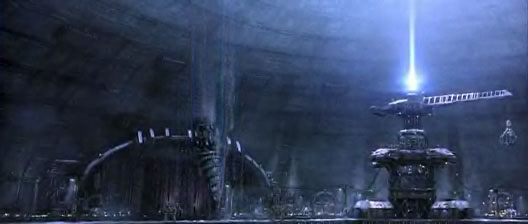 Download. File size: 10.3 megabytes.
Download. File size: 10.3 megabytes.
Second fragment: meeting in subway, statics.
Both dark and light static scenes with low dynamics are present.
- The fragment length is 3 minutes and 32 seconds.
- The fragment bitrate is 129 kilobits.
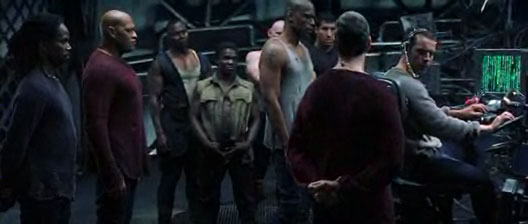 Download. File size: 3.38 megabytes.
Download. File size: 3.38 megabytes.
It is easy to see that even in extremely tough conditions quite tolerant quality for Internet broadcast was achieved. This is not completely “honest” example from the point of view of Internet encoding, as at multipass VBR encoding maximum local bitrate is not limited by anything, and it can achieve values exceeding average file bitrate by several times.
Therefore, we will take The Matrix movie incoded in ABR mode as our last example.
We took HD-DVDrip as the source file. The Rip resolution is 1280x528, the bitrate is about 4 megabits per second. ABR compression mode is the unique feature of the new codec. It allows obtaining the same quality of the image transmitted via the network as CBR mode but saves 30% to 50% traffic of the server to which the video is uploaded. More detailed information about ABR is contained in the codec instructions. The resolution of the compressed video is 528x224 pixels. To resize the original file, we used Spline64Resize filter from AviSynth video processing package. There wasn't any additional video processing. The movie was compressed in ABR mode with the following parameters: maximum bitrate of 300 kilobauds, V.D. level of 40, and 8 seconds buffer size. This means that uninterrupted playing from any keyframe is ensured provided there is a channel of 300 kilobauds and video stream prebuffering of 8 seconds. Of course, bitrate limit of 300 kilobauds is quite hard, but it allows showing how the codec works in extreme conditions. The actual bitrate of the compressed movie made 237 kilobits per second, its size made 236 megabytes. Thus, using ABR mode, we saved 26.5% of traffic with nearly the same video quality compared to CBR. We cut out a fragment with slight quality losses caused by strict bitrate limitation. This was kung fu training scene. Even final battles do not cause such losses. However, you may download the whole movie. It is uploaded without sound.
The last example: kung fu training.
The fragment has very quick movement scenes against high contrast textures, there are also dark scenes.
- The fragment length is 6 minutes and 16 seconds.
- The fragment bitrate is 267 kilobits per second.
 Download. File size: 12.1 megabytes.
Download. File size: 12.1 megabytes.
It can be generally said that irrespective of the unequal conditions with H.264, the obtained quality is not worse than that for example on YouTube, especially taking into account that their “high quality” means the bitrate of 500 kilobits per second 400 of which fall at video...
Conclusions.
It can generally be said that the codec in its present state ensures visual video quality (not PSNR) somewhat beyond of the average H.264 codec, and begins to closely compete, in some cases, to the best to date x264 codec. And this with the absence of even a quarter-pixel movement compensation not saying about multiple reference frames, b-frames, etc. Moreover, it has implemented only very primitive SIF transform type. This testifies that actual potential of the developed technology has not been discovered yet; we cannot say the same about existing codecs of H.264 standard that have already been improved as much as possible.
Moreover, the developed technique has a number of unique properties that “ordinary” codecs do not have and will not have. First of all, it is its “analog” type of distortions, which is much more pleasant for human eye than “digital” smearing of the compressed image.
|